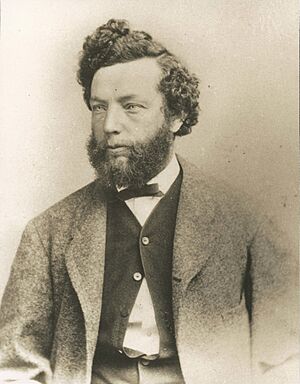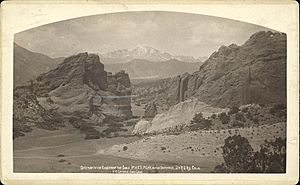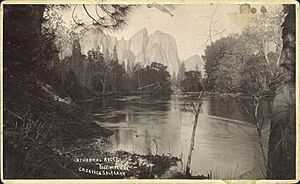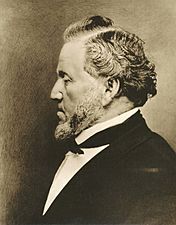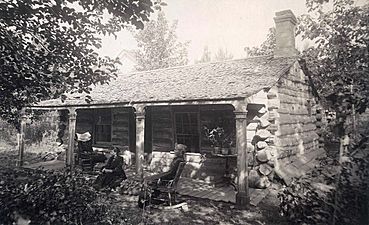Charles Roscoe Savage facts for kids
Quick facts for kids
Charles Roscoe Savage
|
|
|---|---|
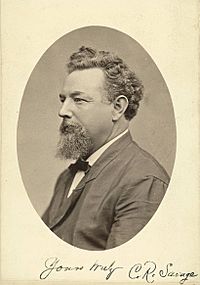
Savage, self-portrait, ca. 1880–90
|
|
| Born | August 16, 1832 |
| Died | February 4, 1909 (aged 76) |
| Nationality | British |
| Occupation | Photographer |
| Known for | American West First transcontinental railroad |
|
Notable work
|
Views of the Great West |
Charles Roscoe Savage (born August 16, 1832 – died February 4, 1909) was a famous photographer. He was born in Britain but became well-known for his pictures of the American West. Savage joined the Church of Jesus Christ of Latter-day Saints when he was young. He served a mission in Switzerland and then moved to the United States.
In America, he became very interested in photography. He started by taking portraits of people for money. Later, he moved to Salt Lake City with his family. There, he opened his own shop called the Art Bazar. He sold many of his amazing photographs there. Savage mostly took pictures of families, beautiful landscapes, and important events. He is most famous for his 1869 photos of the First transcontinental railroad. These pictures show the two halves of the railroad connecting at Promontory, Utah.
Contents
Growing Up and Early Adventures
Charles Roscoe Savage was born in Southampton, England, on August 16, 1832. He was the first of four children. When he was four, his clothes caught fire from a burning wood chip. He suffered some bad burns. Instead of going to school, he sold salt in Southampton. He also helped a coachmaker sharpen tools.
At age 15, on May 25, 1848, he joined the Church of Jesus Christ of Latter-day Saints. His parents did not approve of this choice. Savage moved to the Isle of Wight to work as a fishmonger. He also helped members of his church share their beliefs there. He later returned to Southampton and worked in a stationery shop. His boss, William Eddington, also taught him many things. Savage later said Eddington "placed me as it were on the road to fame."
Savage worked part-time as a secretary for his church's mission president. He collected and recorded donations. In 1853, he became a full-time missionary in Switzerland. There, he learned to speak French and a little German. After 19 months, he returned to England. He met Annie Adkins there. They got married on June 24, 1856. Savage worked in a print shop and took other small jobs. He and a friend experimented with taking stereo graphic photos. These were the first stereo photos of Long Island. He likely learned photography from others, including Edward Covington. In 1859, he went to Florence, Nebraska for a church assignment. While there, he started selling portraits. He then met his family in Council Bluffs, Iowa. He kept selling photographs there.
Starting His Photography Career
In the spring of 1860, Savage traveled to Salt Lake City, Utah Territory with his family. He tried to photograph the Mormon trail during his journey. Sadly, none of those early photos have survived. In 1861, he opened a photography studio with Marsena Cannon. Cannon was another early photographer in Utah. A year later, Cannon moved away. Savage then partnered with artist George M. Ottinger.
Ottinger and Savage helped start the Deseret Academy of Art. This school was soon replaced by the University of Utah. Ottinger painted backgrounds for the Salt Lake Theater. He also took photos of local buildings and landscapes. Savage became very popular for his portraits. Important people in Utah asked him to take their pictures. He was also active in his community. He sang in the Mormon Tabernacle Choir. He also gave talks on different topics. Savage advertised in local newspapers to get more business. He sometimes made collages of baby photos he had taken. Families often bought copies of these special collages. To protect his work, he kept the original glass plate negatives. This gave him control over how his photos were used.
Another photographer, Charles W. Carter, joined Ottinger and Savage's studio. Carter later started his own studio. It can be hard to tell if some photos from this time were taken by Carter or Savage. So, sometimes both photographers are given credit. In 1868, Andrew J. Russell was photographing the building of the Union Pacific Railroad. He met and became friends with Savage. The two photographers often took pictures of the same scenes. They sometimes did this within minutes of each other.
Railroad Photography and New York Trip
By 1866, Savage's photo series, Views of the Great West, was very popular. Railroad companies like the Union Pacific Railroad sold his stereoscopic photos. These railroads gave him free passes to travel anywhere he wanted. In the same year, he visited major photography studios across the United States. He wanted to improve his skills and share his photos. In San Francisco, he met Carleton Watkins, another famous photographer.
Savage traveled by boat to New York City. He was very inspired by the new photography ideas and technology there. In New York, he made a deal with Samuel R. Wells. Wells sold Savage's photos, and Savage sold Wells' books in Utah. Savage made similar deals with other sellers. He had a special darkroom wagon custom made. He spent a lot of money on photography supplies. Sadly, most of his new supplies were lost when his wagon tipped over. This happened while crossing the Platte River on his way back. Savage worked for years to pay off the debt.
Savage took his most famous pictures in 1869. These photos show the Union Pacific and Central Pacific Railroads connecting. This historic event happened at Promontory Summit in Promontory, Utah. He also took many pictures of the Great Basin tribes, like the Northern Paiute people and Shoshone. He photographed beautiful places like Yellowstone National Park and Zion National Park. He also documented the growth of towns and cities in Utah. An artist named Alfred Lambourne often painted scenes while Savage photographed them. Savage traveled widely across western North America. He took pictures in Canada and Mexico, and from the Pacific Ocean to Nebraska. Sadly, many of Savage's original photographs were lost in a big studio fire in 1883.
Many of Savage's photos were printed in Harper's Weekly newspaper. This partnership started when he left photos with their offices during his U.S. tour. It continued until 1870. Then, he started sending photos to Leslie's Illustrated instead.
In 1870, Brigham Young invited Savage to join him on a trip. They visited towns in southern Utah. Savage wrote about his experiences during this trip in a magazine. He also brought his camera. He photographed the main leaders of the trip. He also took pictures of Little Zion Valley, which is now Zion National Park. When Savage returned home, his five-month-old son, Enos, was sick. Enos died shortly after Savage's return. Savage found comfort in his work. He left for California a month after Enos' death.
The Art Bazar and Challenges
By the mid-1870s, Savage's studio was very busy. Many tourists came to his Pioneer Art Gallery. They wanted to buy photographs of the West. Savage realized people needed to appreciate art more. So, he built the Art Bazar. By the late 1870s, there was a high demand for photographs. Savage traveled more often to find new things to photograph. He explored the West by riding on many different railroads. Each one gave him a free pass to ride.
In 1876, Savage married Mary Emma Fowler. She passed away five years later in 1881. At that time, it was common for members of his church to have more than one wife. Three years after Mary's death, Savage married Ellen Fenn. Laws like the Edmunds Act made the local economy in Salt Lake City slow down. However, tourism kept Savage's Art Bazar financially stable. Many people who practiced polygamy were arrested during this time. Savage was never arrested. He was asked by church leaders to visit prisons and preach. When the Edmunds Act didn't work well, Congress passed the Edmunds-Tucker Act. This law took away church property. Savage traveled East to speak out against this law. His efforts did not succeed. Later, the church president, Wilford Woodruff, announced a change. This change, called the 1890 Manifesto, ended the practice of polygamy. This helped Utah become a state.
By the 1880s, Savage's photographs were famous in many states. But on June 26, 1883, a fire burned down the Art Bazar. The cause of the fire is still unknown. The fire destroyed his collection of glass-plate negatives. This meant his famous photos could no longer be copied. Savage thought the damage was worth over $12,000. But his insurance only covered $4,000. The community came together to help him. They raised money to build a new studio. With their help and a small loan, Savage opened a new Art Bazar six months later. To advertise his new shop, he started a newspaper called The Busy Bee. It promoted his business and other local shops. But the newspaper only lasted a few years.
Savage had a great reputation for quality photography. He decided to try dry plate photography. This new method allowed him to work much faster. He quickly retook the famous photographs that had made him well-known. Many western railroads later used these new photos to advertise their train lines.
As Salt Lake City grew, many photographers opened shops near Savage. He helped many of his apprentices start their own businesses. Competition began to increase. To stand out, the Art Bazar started selling Valentine's Day cards.
In April 1892, Savage photographed the outside of the Salt Lake City LDS temple when it was finished. The next year, on Thanksgiving Day, Savage's first wife, Annie, died. She passed away from kidney disease. As Savage got older, he gave the Art Bazar to his sons, Ralph and George. Dry plate photography made it easy for amateur photographers to take pictures. This hurt business for professional studios. So, the Art Bazar started selling photography equipment to amateur photographers. Around 1906, Savage retired from the Art Bazar. He let the next generation continue his business. At 63, he married a widow named Annie Smith Clowes. In 1908, the Inter-Mountain Photographers Association held their convention at the Art Bazar. Savage took many trips in his later years. He wrote travel stories that were printed in local newspapers. In January 1909, he visited the Art Bazar and told his son George he wasn't feeling well. His condition worsened, and he died early on February 3, 1909, from heart failure.
Family Life
One of Savage's daughters, Luacine Annetta Savage, married J. Reuben Clark. He later became an important leader in the LDS Church.
His Lasting Impact
Savage was known as a great railroad photographer. His pictures show fifty years of change in the American West. They capture everything from the early days of the American frontier to the start of the Industrial Age. After he died, John P. Meakin wrote that Savage "was the loving peasant prince of Utah."
Savage's sons, Ralph, Roscoe, and George, kept running the Art Bazar after his death. Ralph Savage was chosen by the LDS Church to photograph the inside of the Salt Lake Temple. His photos were published in a book called The House of the Lord. The Art Bazar almost burned down again a few years after Savage's death. It was only partly damaged, and the main building was saved. However, the fire destroyed Savage's negatives from the last 25 years of his life. The Savage family reopened the Art Bazar to the public. But they mostly sold novelty items and picture frames instead of photographs. The Art Bazar finally closed completely on December 31, 1926.
Selected Works
-
Saltair Beach
-
Portrait of Brigham Young


